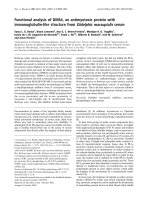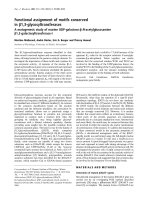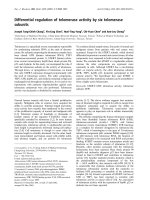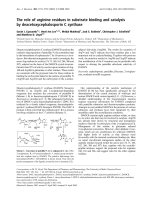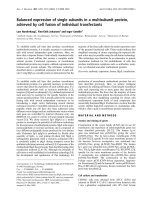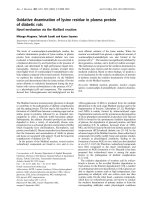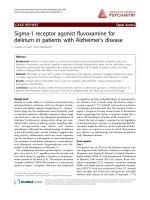Báo cáo y học: " Short-term variability of biomarkers of proteinase activity in patients with emphysema associated with type Z alpha-1-antitrypsin deficiency" pdf
Bạn đang xem bản rút gọn của tài liệu. Xem và tải ngay bản đầy đủ của tài liệu tại đây (340.88 KB, 7 trang )
BioMed Central
Page 1 of 7
(page number not for citation purposes)
Respiratory Research
Open Access
Research
Short-term variability of biomarkers of proteinase activity in
patients with emphysema associated with type Z
alpha-1-antitrypsin deficiency
Jan Stolk*
1
, Barbara Veldhuisen
2
, Laura Annovazzi
3
, Chiara Zanone
3
,
Elly M Versteeg
5
, Toine H van Kuppevelt
5
, Willem Nieuwenhuizen
6
,
Paolo Iadarola
3
and Maurizio Luisetti
4
Address:
1
Department of Pulmonology, Leiden University Medical Center, Leiden, The Netherlands,
2
Department of Medical Statistics, Leiden
University Medical Center, Leiden, The Netherlands,
3
Laboratory of Capillary Electrophoresis, Department of Biochemistry, University of Pavia,
Italy,
4
Laboratory of Biochemistry and Genetics, Department of Respiratory Disease, IRCCS San Matteo Hospital, Pavia, Italy,
5
Department of
Biochemistry, 194, University Medical Center, NCMLS Nijmegen, The Netherlands and
6
TNO-Prevention and Health, Gaubius Laboratory, Leiden,
The Netherlands
Email: Jan Stolk* - ; Barbara Veldhuisen - ; Laura Annovazzi - ;
Chiara Zanone - ; Elly M Versteeg - ; Toine H van Kuppevelt - ;
Willem Nieuwenhuizen - ; Paolo Iadarola - ; Maurizio Luisetti -
* Corresponding author
alpha-1-antitrypsinemphysemaJM403desmosinesbiomarkers
Abstract
Background: The burden of proteinases from inflammatory cells in the lung of subjects with type Pi ZZ
of alpha-1-antitrypsin deficiency is higher than in those without the deficiency. Cross-sectional studies have
shown increased levels of biomarkers of extracellular matrix degradation in vivo. Longitudinal variability of
these biomarkers is unknown but desirable for clinical studies with proteinase inhibitors.
Methods: We measured three different types of biomarkers, including desmosines, elastase-formed
fibrinogen fragments and heparan sulfate epitope JM403, in plasma and urine for a period of 7 weeks in a
group of 12 patients who participated in a placebo-controlled study to assess the safety of a single
inhalation of hyaluronic acid.
Results: Effect of study medication on any of the biomarkers was not seen. Baseline desmosines in plasma
and urine correlated with baseline CO diffusion capacity (R = 0.81, p = 0.01 and R = 0.65, p = 0.05). Mean
coefficient of variation within patients (CVi) for plasma and urine desmosines was 18.7 to 13.5%,
respectively. Change in urinary desmosine levels correlated significantly with change in plasma desmosine
levels (R = 0.84, p < 0.01). Mean CVi for fibrinogen fragments in plasma was 20.5% and for JM403 in urine
was 27.8%. No correlations were found between fibrinogen fragments or JM403 epitope and desmosines.
Conclusion: We found acceptable variability in our study parameters, indicating the feasibility of their use
in an evaluation of biochemical efficacy of alpha-1-antitrypsin augmentation therapy in Pi Z subjects.
Published: 31 May 2005
Respiratory Research 2005, 6:47 doi:10.1186/1465-9921-6-47
Received: 03 February 2005
Accepted: 31 May 2005
This article is available from: />© 2005 Stolk et al; licensee BioMed Central Ltd.
This is an Open Access article distributed under the terms of the Creative Commons Attribution License ( />),
which permits unrestricted use, distribution, and reproduction in any medium, provided the original work is properly cited.
Respiratory Research 2005, 6:47 />Page 2 of 7
(page number not for citation purposes)
Background
Polymorphonuclear leukocytes (PMNs) play a major role
in the pathogenesis of chronic obstructive pulmonary dis-
ease (COPD), in particular in emphysema [1]. In subjects
with Pi Z type of alpha-1-antitrypsin deficiency (AATD)
the burden of PMN and other inflammatory cells in the
lung is higher than in those without the deficiency [2,3].
The serum levels of alpha-1-antitrypsin (AAT) found in
deficient AAT subjects with phenotypes ranging between
Null/Null and MZ correlate with clinical severity of
emphysema and suggest that AAT is the most important
inhibitor of protease activity in the lung [4]. Proteinases
released by inflammatory cells such as PMN and macro-
phages are able to degrade the extracellular matrix compo-
nents in lung interstitium, including elastin,
proteoglycans and collagens [5]. Although active degrada-
tion is difficult to demonstrate in vivo, immunohisto-
chemical studies in resected human lung have shown
PMN elastase and other proteases present on extracellular
matrix components, suggesting that enzyme is in contact
with its substrate for degradation [6]. In patients with
AATD, such degradation is thought to be more active in
the absence of AAT.
The assessment of inflammatory cell-mediated extracellu-
lar matrix degradation in vivo partly suffers from the lack
of specific biochemical markers that reflect proteolysis
and thus protease activity in vivo. For example, neutrophil
elastase can be measured in plasma as antigen concentra-
tion or in complex with its inhibitor alpha-1-antitrypsin,
but this is only an indication of PMN degranulation and
may not be representative of functional extracellular pro-
teolytic activity in vivo.
In the past five years, three different concepts of biomark-
ers of protease activity of extracellular matrix degradation
around inflamed alveoli have been published. First, the
heparan sulfate specific epitope JM403 was found 10-fold
reduced in urine of patients with COPD compared to
healthy controls [7]. The decreased urinary content of a
specific epitope of heparan sulfate, together with a normal
content of heparan sulfate richly present in basement
membranes of alveoli suggest a structural alteration or an
altered processing of the heparan sulfate molecule in the
lungs of patients with emphysema. In view of the biolog-
ical functions of heparan sulfate, this could lead to desta-
bilisation of the extracellular matrix, facilitating the
development of further proteolytic damage to other
matrix components [7].
Second, elastin breakdown products were demonstrated
in urine and plasma, as a footprint of the degradation of
cross-linked elastin [8-10]. Third, large fibrin(ogen) frag-
ments formed by neutrophil elastase-mediated degrada-
tion (PMN-FDP) were significantly elevated in plasma of
AATD subjects compared to healthy controls, indicating
an imbalance in the protease-antiprotease ratio, which
allows elastase activity in vivo at sites of inflammation
where fibrin(ogen) is deposited [11,12].
The aim of the present study was to measure the above
three types of biomarkers in a short-term pharmaceutical
safety study to assess biomarker variability between and
within patients.
Materials and methods
Subjects and study design
Twelve patients with Pi ZZ type of AATD participated in a
double blind, randomised, placebo-controlled phase I
study to investigate the safety and tolerability of a single
inhalation of hyaluronic acid (HA), using a Pari Boy com-
pressor and LC nebuliser [13]. Patients were randomised
for a single inhalation of a solution of HA (0.003 or
0.01% ETX-100 from CoTherix, Belmont, CA, USA) or
placebo. This resulted into 3 blocks of treatment, a block
of 4 patients who inhaled 0.003% ETX-100 or placebo, a
block of 4 patients who inhaled 0.01% ETX-100 or pla-
cebo and another block of 4 patients who inhaled 0.003
or 0.01% ETX-100. These dosages were calculated from
dosages that have been used in standard toxicity studies in
mice and rats, required by the Food and Drug Administra-
tion of the USA, to demonstrate a no effect level in stand-
ardized pathological examination. The two inhalations
were 15 days apart. The first single inhalation was at base-
line visit with overnight stay in the clinic, followed by a
control visit on day 9. The second single inhalation was at
day 15, followed by another overnight stay in the clinic
and by a control visit on day 23. A final visit was sched-
uled 44 days after the baseline visit. Citrate plasma sam-
ples were taken at baseline and days 1, 9, 15, 16, 23 and
44. Urine samples of 24 h period of collection were taken
on days 1, 9, 16, 23 and 44.
Patient characteristics are shown in Table 1 (see
AdditionalfileRespirResTable1). Although no chest CT's
were available, chest X-rays of all patients showed signs of
panlobular emphysema and none showed bronchiectasis.
All patients were in stable clinical condition in the four
weeks preceding the baseline visit and none have ever
been treated with AAT replacement therapy.
The study was approved by the Ethical Board of LUMC
and all patients gave written informed consent. The study
was conducted according to Good Clinical Practice.
Desmosine assay
The determination of desmosines in urine was performed
essentially as previously described [14]. For analysis of
these compounds in plasma, the above method was
slightly modified. Briefly, plasma samples (1 ml) were
Respiratory Research 2005, 6:47 />Page 3 of 7
(page number not for citation purposes)
deproteinized by addition of 0.45 M trichloroacetic acid
(400 µl) and centrifuged at 14,000 rpm for 10 min.
Finally, a 100 µl aliquot of each sample was placed into
pyrex tubes, evaporated to dryness in vacuo and hydro-
lyzed by refluxing with 500 µl of twice distilled constant
boiling HCl (6 M) at 106°C for 24 h. The hydrolyzed sam-
ples were dried under a nitrogen stream, the residue
washed four times in de-ionized water and neutralized
with 0.5 M Na
2
CO
3
, pH 8.7 to give a final volume of 500
µl. After centrifugation for 15 min at 13,000 rpm, the
supernatant was diluted with water (1:1) and labeled for
5 hrs at 45°C in the dark by addition of 50 µl 0.5 mM flu-
oresceine isothiocyanate (FITC) solution prepared fresh
immediately before of use. Samples were then analyzed
with capillary electrophoresis and laser-induced fluores-
cence detection (CE-LIF) using a Beckman P/ACE 2200
(Fullerton, CA, USA) automated system equipped with a
LASER MODULE 488 (Beckman) consisting of a 3 mW
and a 488 nm air-cooled argon-ion laser. Samples were
injected at 3.5 kPa for 10 sec (approximately 10 nl
injected) and the separation was carried out at a tempera-
ture of 25°C applying a voltage of 30 kV for 25 min. The
background electrolyte was 20 mM sodium tetraborate
pH 9.0 containing 60 mM sodio dodecyl sulfate and 15%
(v/v) methanol. Data were collected and processed using
the Beckman System Gold software. The assay is measur-
ing the combination of isodesmosine and desmosine
present in both plasma and urine samples. Throughout
this manuscript it is referred to as desmosines. The calcu-
lated analytical interassay coefficient of variation (CVa)
was 4.2 %. Desmosines concentration in urine is normal-
ized to urine creatinine (µg/g creatinine), whereas
desmosines concentration in plasma is expressed as µg/L.
JM403 assay
The heparan sulfate JM403 epitope, defined by mono-
clonal antibody JM403 was quantified using an inhibition
enzyme immunoassay (EIA) as previously described [7].
The EIA was preceded by urine preparation as described
[7]. The CVa of the assay was 5 %.
PMN-FDP assay
Frozen citrate plasma was warmed for 5 – 10 min in a
37°C water bath until the sample was a clear solution.
Capture-antibody-coated microtiter plates from Kordia
BV, Leiden, The Netherlands were filled with samples
diluted in PBS/Tween and incubated for 2 h at room tem-
perature. Bound PMN-FDP was quantified by incubation
for 1 h at RT with peroxidase-labelled Mab DD13 in PBS/
Tween with 0.1% (w/v) BSA, and the subsequent conver-
sion of TMB/H
2
O
2
as described [11]. The CVa of the assay
was 10%.
Statistical analysis
After the code of treatment was broken, the change over
time from baseline to day 15 and from day 15 to day 44
for each of the treatment groups was calculated for each of
the three different biomarkers. To test for a treatment
effect of hyaluronic acid on each of the biomarkers, the
differences between two time points for a given biomarker
in the treatment groups was compared with the differ-
ences in the group treated with placebo using an univari-
ate general linear model. A t-test for the inter-subject
variability for each of the biomarkers in each of the three
treatment blocks showed no statistically significant
difference.
Mean values and standard deviations of desmosines, JM
403 and PMN-FDP of all available plasma or urine sam-
ples for each of the days of collection were calculated in
SPSS version 11. Coefficient of variation within and
between patients was calculated.
The correlation between baseline FEV
1
, Kco and baseline
value of each of the biomarkers was assessed by the Spear-
man's rank correlation coefficient.
Results
Analysis of change over time of any of the three biomark-
ers for a given treatment with hyaluronic acid did not
show a statistically significant difference compared to
change by placebo treatment in a univariate general linear
statistical model. Therefore, all data of each biomarker are
shown for the 12 patients as a single study group.
The study medication was well tolerated and only 5 mild
adverse events were possibly treatment-related. There
were no clinically important changes in lung function or
safety variables.
Assay results
The mean values of desmosines and PMN-FDP of the 12
patients for each of the study days were all in the same
range (Figure 1, 2, 3). Previously published values in
healthy individuals are mentioned in the legend to the fig-
ures. Except for patient 4 and 10, JM403 values were
within the range of values for patients with general COPD
[7]. The JM 403 epitope in urine of patient 4 (FEV
1
46%
pred., Kco 40% pred.) and 10 (FEV
1
30% pred., Kco 50%
pred.) showed a markedly elevated value that was in the
range of previously published values for healthy subjects
(Figure 4) [7].
Spearman's rank correlation coefficient between baseline
lung function values of the patients and each of the base-
line biomarkers is presented in Table 2 (see DOC
AdditionalfileRespirResTable2). Spearman's correlation
of change over time between plasma desmosines and
Respiratory Research 2005, 6:47 />Page 4 of 7
(page number not for citation purposes)
urine desmosines in the 12 patients was 0.84 (P < 0.01)
and is shown in Figure 5. No such significant correlation
was present for the two other biomarkers.
The coefficient of variation (CV) calculated within and
between patients is presented in Table 3 (see DOC
AdditionalfileRespirResTable3). Mean coefficient of
variation within patients (CVi) for plasma and urine
desmosines was 18.7 to 13.5%, respectively. Mean CVi for
fibrinogen fragments in plasma was 20.5% and for JM403
in urine was 27.8%.
Discussion
The results of this 44-day follow up study showed for the
first time the variability of biomarkers of matrix degrada-
tion within and between patients with Pi ZZ type of alpha-
1-antitrypsin deficiency and emphysema. Furthermore,
the present baseline results confirm values of similar
patients in previously published cross-sectional studies
where the outcome was compared with control subjects
[7-9,11]. The patients in the present study were carefully
controlled during the conduct of the study, including two
overnight stays in the clinic and three visits in the out
patient clinic, allowing optimal conditions for sample col-
lection and preparation.
The assays were performed in three different laboratories,
each with their own expertise built up in the past 5 years.
For the JM403 epitope assay, urine samples needed spe-
cific pre-treatment [7]. Glycosaminoglycans were first iso-
lated by an ion-exchange column and quantified. From
the glycosaminoglycan eluate, a sample was used for the
JM403 EIA. When values of our patients 4 and 10 with
high JM403 levels are taken out, a mean of 0.7 ± 0.2 U/mg
creatinine is highly comparable to the previously pub-
lished value of 0.6 ± 0.1 U/mg creatinine, indicating stable
assay performance of the EIA despite a complicated sam-
ple preparation. This is in contrast to the PMN-FDP assay
[11]. We learned that cryo-precipitation of fibrinogen and
large fibrinogen fragments in plasma samples requires
careful sample handling, including snap freezing and
rapid thawing to 37°C to prevent the formation of cryo-
precipitates within the sample. In a previous report on this
assay, our values for Pi ZZ patients were ten-fold lower, as
these samples were thawed to and measured at room tem-
perature [11]. To minimize solute losses in the system and
to decrease the degree of variability of data, the determi-
nation of urinary desmosines was performed on urine
Plasma desmosines levels (median ± quartels presented as box together with minimal and maximal values) determined on samples collected on indicated days from the patientsFigure 1
Plasma desmosines levels (median ± quartels presented as
box together with minimal and maximal values) determined
on samples collected on indicated days from the patients.
Values of plasma desmosines in healthy individuals (n = 15)
range between 40 and 60 µg/l, mean 43 ± 3 µg/l (mean ± SD,
reference 16).
Urine desmosines levels (median ± quartels) determined on samples collected on indicated days from the study patientsFigure 2
Urine desmosines levels (median ± quartels) determined on
samples collected on indicated days from the study patients.
Ten healthy individuals had mean values of 22.70 ± 1.66 µg/g
creatinine (mean ± SD, reference 14).
Respiratory Research 2005, 6:47 />Page 5 of 7
(page number not for citation purposes)
samples not submitted to any pretreatment procedure
other than filtering the sample. For all three assays, it is
possible to measure values with an analytical inter-assay
coefficient of variation (CVa) below 10%. This is well
below 15% which is the value derived from the criterion
that the CVa should be below half of the intra-individual
coefficient of variation (CVi), with ranges between indi-
viduals reported in Table 3. Therefore, all three assays
have acceptable variability and can be used for studies that
aim to evaluate the effect of drugs on the level of these
biomarkers [15].
The key question about all three of our assays is whether
they only reflect matrix degradation present in lung inter-
stitium or whether significant other parts in the body also
contribute to elevated plasma levels of the biomarkers.
Recent data showed abnormal high levels of desmosines
in plasma and urine of patients affected by Pseudoxan-
thoma elasticum, an inherited disorder of connective tissue
characterized by severe alterations of its components [16].
As COPD/emphysema is now recognised not only as a
pulmonary condition, but also as a systemic disorder,
including skeletal muscle wasting and skin atrophy, it is
possible that other tissues in the body also contributed to
the levels of our biomarkers due to the same processes.
Furthermore, almost all patients with COPD/emphysema
have a history of cigarette smoking that may also result in
vascular atherosclerosis, a condition that is able to affect
the levels of our biomarkers. To our knowledge, no lung
specific protein, sensitive to proteolytic cleavage, has been
identified yet to serve as a useful substrate for proteolysis
to act as a footprint of inflammation-induced matrix
destruction specific for the lung. Therefore, the most
appropriate way to study the contribution of inflamma-
tion-induced lung matrix degradation would be the use of
specific protease inhibitors in patients and to measure
their effects on levels of our biomarkers. So far, urinary
desmosines only has been used to monitor the efficacy of
the AAT replacement therapy in short-term, open label tri-
als in AATD subjects [17,18]. The latter study showed a
small, but not significant, decrease in desmosines excre-
tion after 24 weeks of replacement therapy, which
Plasma fibrinogen fragments generated by PMN (PMN-FDP) determined on samples collected on indicated days from the study patients (median ± quartels)Figure 3
Plasma fibrinogen fragments generated by PMN (PMN-FDP)
determined on samples collected on indicated days from the
study patients (median ± quartels). Ten healthy individuals
had mean values of 35 ± 12 ng/ml (mean ± SD, reference 11).
Urine JM403 values corrected for urine creatinine concentra-tion on samples collected on indicated days from the study patientsFigure 4
Urine JM403 values corrected for urine creatinine concentra-
tion on samples collected on indicated days from the study
patients. Individual values are shown to appreciate the differ-
ences between patients. Values are expressed as Units/mg
creatinine. One unit is defined as the amount of JM403
epitope present on 1 microgram kidney heparan sulfate. Sam-
ple on Day 9 of patient X is missing because he forgot to col-
lect the sample. The top line of asterixes represents data
from a patient that also had stable chronic pancreatitis, a
condition not known to be associated with type Z alpha-1-
antitrypsin deficiency. The other patient with normal values
had no other known conditions and had a stable lung func-
tion for the past 15 years as measured in our clinic.
Respiratory Research 2005, 6:47 />Page 6 of 7
(page number not for citation purposes)
suggests that reversal of chronic proteolysis in AATD can-
not be achieved quickly. Just like in the above-mentioned
studies, also our study was of short-term duration and no
change in spirometry or CO diffusion capacity is to be
expected. Therefore, a definitive answer to the question
whether the increased urinary excretion in AATD-associ-
ated COPD is mostly due to accelerated proteolysis within
the lung would require a more extended period of replace-
ment therapy (probably more than one year) or a higher
dose than currently used. Apart from above mentioned
manuscripts, all the other reports dealing with matrix deg-
radation biomarkers in COPD have been designed in a
cross-sectional fashion [8,9,19].
A unique feature of the present study is that three different
laboratories have united to measure three different
biomarkers of matrix degradation in two different biolog-
ical fluids being serially collected from a well-defined
study population. Such collaboration arose from the
Alpha
1
International Registry (AIR), a consortium of sci-
entists with special interest in AATD [20]. In this study,
urinary and plasma desmosines have been detected simul-
taneously for the first time in these patients. Plasma nor-
mally contains peptides derived either from tropoelastin
or from degraded crosslinked mature elastin. It has been
reported that these circulating peptides have a wide vari-
ety of sizes, peaking at 70 kD, but with a significant pro-
portion of peptides with lower molecular weight. The
latter are expected to more easily filter into urine. Chro-
matographic separation of urine elastin peptides in
humans has detected material over a wide range of MW,
from < 5 kD to > 50 kD, peaking at 10–50 kD [21]. Detec-
tion of desmosines allows discrimination, among elastin
peptides, of those derived from the breakdown of mature
elastin from those derived from nascent elastin. The good
correlation between urinary and plasma desmosines here
shown is consistent with the correlation between urinary
and plasma elastin peptides previously reported,
suggesting that plasma and urine provide generally com-
parable estimates of elastin turnover, at least in a short-
term [21]. The high cross-sectional correlation between
baseline CO diffusion capacity and both urine and
plasma desmosines and the absence of such correlation
with either PMN-FDP or JM403 raises the question as to
whether one is better than the other. Differential changes
in any of these biomarkers during acute exacerbations or
AAT supplementation therapy may answer this question.
In addition, all three parameters do not seem to correlate
with each other. This may in part be explained by a differ-
ence in clearance from the body. The half-life of
desmosines-containing elastin fragments in mice is about
2 h [22], about 5 days for PMN-FDP in humans [23] and
is unknown for JM403.
Conclusion
We have shown, compared to previously reported healthy
individuals, significantly altered levels of three different
surrogate markers representing footprints of matrix degra-
dation simultaneously present in patients with type Z
alpha-1-antitrypsin deficiency and clinically significant
emphysema. In addition, acceptable variability in our
study parameters occurred. The footprints are recom-
mended for use in an evaluation of biochemical efficacy
of alpha-1-antitrypsin augmentation therapy in Pi Z sub-
jects before initiation of studies involving functional tests
of the lung and CT scan lung density assessment [24].
Abbreviations
AAT, alpha-1-antitrypsin
AATD, alpha-1-antitrypsin deficiency
CE-LIF, capillary electrophoresis and laser-induced fluo-
rescence detection
COPD, chronic obstructive pulmonary disease
FITC, fluoresceine isothiocyanate
Change in plasma desmosines level and change in urine desmosines level during the 44 days of the study assessed for each of the 12 participating patientsFigure 5
Change in plasma desmosines level and change in urine
desmosines level during the 44 days of the study assessed for
each of the 12 participating patients. Spearman's rank corre-
lation coefficient between individual change in plasma and
urine desmosines is 0.84 (P < 0.01).
Respiratory Research 2005, 6:47 />Page 7 of 7
(page number not for citation purposes)
HA, hyaluronic acid
EIA, inhibition enzyme immunoassay
Kco, CO diffusion capacity per volume unit of alveolar
ventilation
PMN-FDP, neutrophil elastase-mediated degradation
PMNs, polymorphonuclear leukocytes
Competing interests
Financial support: The study was conducted as a phase I
study in collaboration with CoTherix, Belmont, CA, USA
who financially supported the study.
All authors declared no conflict of interest with the con-
tent of the manuscript.
Authors' contributions
All authors contributed to the content of the manuscript.
The desmosines were measured by LA, CZ and PI. WN was
responsible for the PMN-FDP assay. TK and EV performed
the JM403 assay and BV performed the statistical analysis.
JS and ML were responsible for the clinical work and JS
wrote the manuscript. All authors have read the text and
contributed corrections.
Acknowledgements
The antibody for JM403 was kindly provided by prof. J.H.M. Berden,
Department of Nephrology, Nijmegen University Medical Center. Discus-
sions with members of the Alpha1 International Registry (AIR, http://
www.aatregistry.org) were much appreciated. Part of the work on
desmosines was funded by Fondazione Cariplo (Milan, Italy) # 2003 1643/
10.8485.
References
1. Barnes PJ, Shapiro SD, Pauwels RA: Chronic obstructive pulmo-
nary disease: molecular and cellular mechanisms. Eur Respir J
2003, 22:672-688.
2. Morrison HM, Kramps JA, Afford SC, Burnett D, Dijkman JH, Stock-
ley RA: Elastase inhibitors in sputum from bronchitic patients
with and without alpha 1-proteinase inhibitor deficiency:
partial characterization of a hitherto unquantified inhibitor
of neutrophil elastase. Clin Sci 1987, 73:19-28.
3. Parmar JS, Mahadeva R, Reed BJ, Farahi N, Cadwallader KA, Keogan
MT, Bilton D, Chilvers ER, Lomas DA: Polymers of alpha(1)-anti-
trypsin are chemotactic for human neutrophils: a new para-
digm for the pathogenesis of emphysema. Am J Respir Cell Mol
Biol 2002, 26:723-730.
4. Cox DW, Levison H: Emphysema of early onset associated
with a complete deficiency of alpha-1-antitrypsin (null
homozygotes). Am Rev Respir Dis 1988, 137:371-375.
5. Mahadeva R, Shapiro SD: Chronic obstructive pulmonary dis-
ease * 3: Experimental animal models of pulmonary
emphysema. Thorax 2002, 57:908-914.
6. Damiano VV, Tsang A, Kucich U, Abrams WR, Rosenbloom J, Kimbel
P, Fallahnejad M, Weinbaum G: Immunolocalization of elastase
in human emphysematous lungs. J Clin Invest 1986, 78:482-493.
7. Van de Lest CH, Versteeg EM, Veerkamp JH, Berden JH, van den Born
J, Heunks L, Lammers JW, van Herwaarden CL, Dekhuijzen PN, van
Kuppevelt TH: Altered composition of urinary heparan sulfate
in patients with COPD. Am J Respir Crit Care Med 1996,
154:952-958.
8. Stone PJ, Gottlieb DJ, O'Connor GT, Ciccolella DE, Breuer R, Bryan-
Rhadfi J, Shaw HA, Franzblau C, Snider GL: Elastin and collagen
degradation products in urine of smokers with and without
chronic obstructive pulmonary disease. Am J Respir Crit Care
Med 1995, 151:952-959.
9. Viglio S, Iadarola P, Lupi A, Trisolini R, Tinelli C, Balbi B, Grassi V,
Worlitzsch D, Doring G, Meloni F, Meyer KC, Dowson L, Hill SL,
Stockley RA, Luisetti M: MEKC of desmosine and isodesmosine
in urine of chronic destructive lung disease patients. Eur Respir
J 2000, 15:1039-1045.
10. Kucich U, Christner P, Lippmann M, Kimbel P, Williams G, Rosen-
bloom J, Weinbaum G: Utilization of a peroxidase antiperoxi-
dase complex in an enzyme-linked immunosorbent assay of
elastin-derived peptides in human plasma. Am Rev Respir Dis
1985, 131:709-713.
11. Bos R, van Leuven CJM, Stolk J, Hiemstra PS, Ronday HK, Nieuwen-
huizen W: An enzyme immunoassay for polymorphonuclear
leucocyte-mediated fibrinogenolysis. Eur J Clin Invest 1997,
27:148-156.
12. Pacholok SG, Davies P, Dorn C, Finke P, Hanlon WA, Mumford RA,
Humes JL: Formation of polymorphonuclear leukocyte
elastase: alpha 1 proteinase inhibitor complex and A alpha
(1–21) fibrinopeptide in human blood stimulated with the
calcium ionophore A23187. A model to characterize inhibi-
tors of polymorphonuclear leukocyte elastase. Biochem
Pharmacol 1995, 49:1513-1520.
13. Turino GM, Cantor JO: Hyaluronan in respiratory injury and
repair. Am J Respir Crit Care Med 2002, 167:1169-1175.
14. Annovazzi L, Viglio S, Perani E, Luisetti M, Baraniuk J, Casado B, Cetta
G, Iadarola P: Capillary electrophoresis with laser induced flu-
orescence detection of urinary desmosines. Electrophoresis
2004, 25:683-691.
15. Harris EK: Statistical principles underlying analytic goal-set-
ting in clinical chemistry. Am J Clin Pathol 1979, 72:374-82.
16. Annovazzi L, Viglio S, Gheduzzi D, Pasquali-Ronchetti I, Zanone C,
Cetta G, Iadarola P: High levels of desmosines in urine and
plasma of patients with pseudoxanthoma elasticum. Eur J Clin
Invest 2004, 34:156-164.
17. Gottlieb DJ, Luisetti M, Stone PJ, Allegra L, Cantey-Kiser JM, Grassi
C, Snider GL: Short-term supplementation therapy does not
affect elastin degradation in severe alpha(1)-antitrypsin defi-
ciency. The American-Italian AATD Study Group. Am J Respir
Crit Care Med 2000, 162:2069-2072.
18. Stoller JK, Rouhani F, Brantly M, Shahin S, Dweik RA, Stocks JM,
Clausen J, Campbell E, Norton F: Biochemical efficacy and safety
of a new pooled human plasma alpha(1)-antitrypsin,
Respitin. Chest 2002, 122:66-74.
19. Ma S, Lieberman S, Turino GM, Lin YY: The detection and quan-
titation of free desmosine and isodesmosine in human urine
and their peptide-bound forms in sputum. Proc Natl Acad Sci U
S A 2003, 100:12941-12943.
20. Luisetti M, Miravitlles M, Stockley RA: Alpha1-antitrypsin defi-
ciency: a report from the 2nd meeting of the Alpha One
International Registry, Rapallo (Genoa, Italy), 2001. Eur Respir
J 2002, 20:1050-1056.
21. Schriver EE, Davidson JM, Sutcliffe MC, Swindell BB, Bernard GR:
Comparison of elastin peptide concentrations in body fluids
from healthy volunteers, smokers, and patients with chronic
obstructive pulmonary disease. Am Rev Respir Dis 1992,
145:762-766.
22. Stracher B, Peterson B: The kinetics of elastolysis: elastin catab-
olism during experimentally induced fibrosis. Exper Lung Res
1998, 25:407-424.
23. Stolk J, Nieuwenhuizen W: High dose intravenous AAT and
plasma neutrophil derived fibrinogen fragments. Thorax 2005,
60:84. (letter to the editor)
24. Dirksen A, Dijkman JH, Madsen F, Stoel B, Hutchison DC, Ulrik CS,
Skovgaard LT, Kok-Jensen A, Rudolphus A, Seersholm N, Vrooman
HA, Reiber JH, Hansen NC, Heckscher T, Viskum K, Stolk J: A ran-
domised clinical trial of alpha(1)-antitrypsin augmentation
therapy. Am J Respir Crit Care Med 1999, 160:1468-1472.
